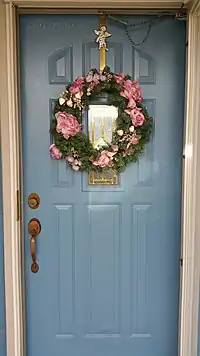House blessing
House blessings (also known as house healings, house clearings, house cleansings and space clearing) are rites intended to protect the inhabitants of a house or apartment from misfortune, whether before moving into it or to "heal" it after an occurrence. Many religions have house blessings of one form or another.[1]
Christianity

In Christianity, house blessing is an ancient tradition, that can be found in Roman Catholicism, Orthodox Christianity, and some branches of Protestantism. In Roman Catholicism, Lutheranism, Anglicanism, Methodism and Orthodoxy, they are usually performed by a pastor who may sprinkle holy water (depending on denominational tradition) as he walks through every room of the house, accompanied by the occupants of the house, whilst praying for the occupants.[1][2]
House blessings date back to the early days of Christianity,[1] and in Catholicism, the rite takes the form of a prayer, with intercessions and several benedictions. Blessed salt and incense may also be used.[3] The Methodist The Book of Worship for Church and Home (1965) contains "An Office for the Blessing of a Dwelling".[4] Matthew 2:11 says:[5]
"On coming to the house, they saw the child with his mother Mary, and they bowed down and worshiped him. Then they opened their treasures and presented him with gifts of gold and of incense and of myrrh."
Consequently, Anglicans, Catholics, Lutherans, Methodists and Orthodox Christians often have their homes blessed at Epiphany, on January 6; this blessing often starts with the Christian custom of chalking the door and prayer at the home altar.[6] The custom of the Epiphanytide house blessing commemorates the visitation of the Magi to the child Jesus.[7] The rite may also be accompanied by a home enthronement, although this is a separate ceremony and is more focused on the consecration of the occupants of the home.
House blessings in the Pennsylvania Dutch Country take the form of printed cards, framed and hung on the walls of the sitting room, and trace their origins to similar practices in The Netherlands and Belgium. Blessings, employed by Catholics and Protestants alike, usually incorporate a picture of Christ's crucifixion and a prayer "to the Sweet Name of Jesus and His dear saints". Many of these were printed in Belgium, and Turnhout.[8]
In Alsace, such blessings have origins in the Pestbriefe (pestilence letters) of the Middle Ages, sold at fairs to those wishing to protect themselves from disease, and the Feuerbriefe (fire letters) brought back by pilgrims from Cologne and containing intercessory prayers to the Three Kings (usually with the letters "CMB", for Caspar, Melchior, Balthasar, incorporated somewhere into the design) for God protecting their homes from fire and disaster. Other blessings, found in Alsace and brought to Pennsylvania, include blessings of the entranceway to a house, stable blessings invoking Saint Leonard or Saint Blasius, blessings against Feuer und Brand addressed to Saint Agatha, and even blessings for house pets addressed to Saint Florentius.[8]
Hinduism
In the Hinduism, a house blessing is conducted always before the people move in. With a new house, this is after construction is finished, but in a purchased house it will be done after purchase but before moving in. The blessing is performed by a Hindu priest and varies greatly throughout India. In Gujarat, the blessing mainly consists of performing abhisheka to a murti, often of Lord Ganesha, which is performed by the house-holders while the priest chants mantras. In Tamil Nadu, the traditional house blessing comprises the chanting of mantras, the escorting of a cow through all of the rooms, and (finally) the boiling of some of the cow's milk in the kitchen. Cow urine (komiyam) is also used for bathing.[9]
Buddhism
The Kojangi house blessing ceremony requires one fresh whole red fish, rice with azuki beans (sekihan), a small bottle of sake, an unopened bag of rice, and a new bag of rock salt.[10]`
In the Gurung culture of Nepal most families have a house blessing twice a year in March and October performed by a Lama priest. At the October blessing a new set of prayer flags are hung at the house (typically on a bamboo pole) with a blessing scarf tied at the top of the prayer flags and a mixture of grains in a bag tied at the bottom.
References
- "House Blessing". American Communications Foundation. 2003-08-01. Archived from the original on 2007-04-03. Retrieved 2008-10-18.
- Jenny Schroedel (2006). The Everything Mary Book. Everything Books. p. 209. ISBN 9781593377137.
- "Blessing of a New Home". Living the Catholic Life - Culture. Catholic Culture. Retrieved 2008-10-18.
- The Book of Worship for Church and Home: With Orders of Worship, Services for the Administration of the Sacraments and Other Aids to Worship According to the Usages of the Methodist Church. Methodist Publishing House. 1964. p. 373. Retrieved 25 March 2017.
- "Matthew 2:11 (New International Version)". The Bible. BibleGateway.com. Retrieved 2008-10-18.
- Williams, Robert (2013). Just As I Am: A Practical Guide to Being Out, Proud, and Christian. Crown Publishing Group.
- Aaron, Bob (23 December 2006). "'Tis the season when many of us bless our homes". Toronto Star. TheStar.com. Retrieved 2008-10-18.
- Don Yoder (2005). "House Blessings and Heaven Letters". The Pennsylvania German Broadside. Penn State Press. pp. 195–198. ISBN 9780271026794.
- Peter Nabokov (2003). "Architecture, Domestic: India and Nepal". In Peter J. Claus; Sarah Diamond; Margaret Ann Mills (eds.). South Asian Folklore. Taylor & Francis. p. 29. ISBN 9780415939195.
- Joseph M. Gardewin (2000). "Bishop Jiku Rose: A Tendai Ajari in Hawai'i". In Karma Lekshe Tsomo (ed.). Innovative Buddhist Women. Routledge. p. 260. ISBN 9780700712199.
Further reading
- Stuart M. Matlins & Arthur J. Magida (1999). "The Home Blessing". How to Be a Perfect Stranger. Wood Lake Publishing Inc. pp. 152–154. ISBN 9781896836287. — a guide to the etiquette of Greek Orthodox house blessing ceremonies
